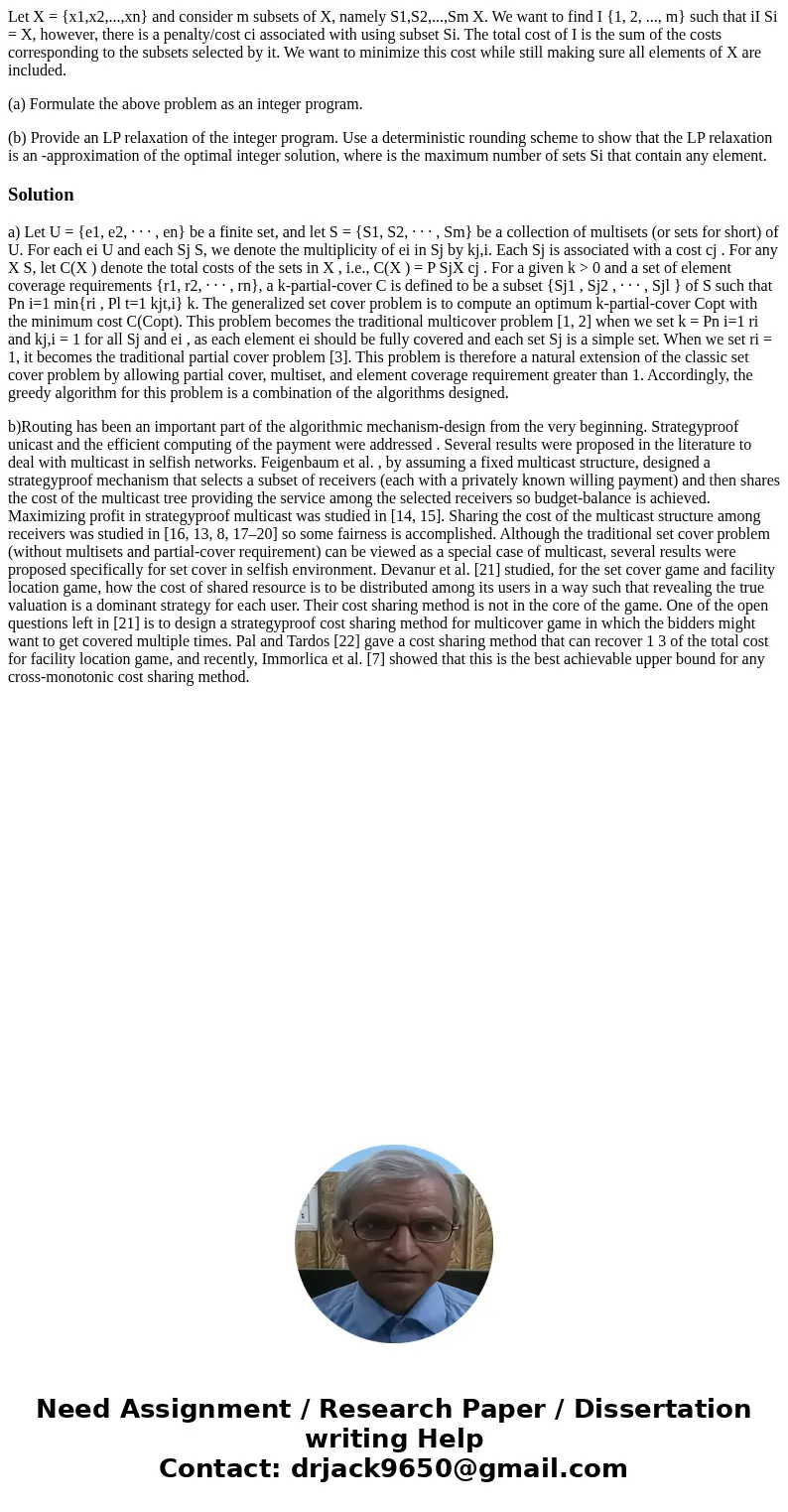Let X x1x2xn and consider m subsets of X namely S1S2Sm X We
Let X = {x1,x2,...,xn} and consider m subsets of X, namely S1,S2,...,Sm X. We want to find I {1, 2, ..., m} such that iI Si = X, however, there is a penalty/cost ci associated with using subset Si. The total cost of I is the sum of the costs corresponding to the subsets selected by it. We want to minimize this cost while still making sure all elements of X are included.
(a) Formulate the above problem as an integer program.
(b) Provide an LP relaxation of the integer program. Use a deterministic rounding scheme to show that the LP relaxation is an -approximation of the optimal integer solution, where is the maximum number of sets Si that contain any element.
Solution
a) Let U = {e1, e2, · · · , en} be a finite set, and let S = {S1, S2, · · · , Sm} be a collection of multisets (or sets for short) of U. For each ei U and each Sj S, we denote the multiplicity of ei in Sj by kj,i. Each Sj is associated with a cost cj . For any X S, let C(X ) denote the total costs of the sets in X , i.e., C(X ) = P SjX cj . For a given k > 0 and a set of element coverage requirements {r1, r2, · · · , rn}, a k-partial-cover C is defined to be a subset {Sj1 , Sj2 , · · · , Sjl } of S such that Pn i=1 min{ri , Pl t=1 kjt,i} k. The generalized set cover problem is to compute an optimum k-partial-cover Copt with the minimum cost C(Copt). This problem becomes the traditional multicover problem [1, 2] when we set k = Pn i=1 ri and kj,i = 1 for all Sj and ei , as each element ei should be fully covered and each set Sj is a simple set. When we set ri = 1, it becomes the traditional partial cover problem [3]. This problem is therefore a natural extension of the classic set cover problem by allowing partial cover, multiset, and element coverage requirement greater than 1. Accordingly, the greedy algorithm for this problem is a combination of the algorithms designed.
b)Routing has been an important part of the algorithmic mechanism-design from the very beginning. Strategyproof unicast and the efficient computing of the payment were addressed . Several results were proposed in the literature to deal with multicast in selfish networks. Feigenbaum et al. , by assuming a fixed multicast structure, designed a strategyproof mechanism that selects a subset of receivers (each with a privately known willing payment) and then shares the cost of the multicast tree providing the service among the selected receivers so budget-balance is achieved. Maximizing profit in strategyproof multicast was studied in [14, 15]. Sharing the cost of the multicast structure among receivers was studied in [16, 13, 8, 17–20] so some fairness is accomplished. Although the traditional set cover problem (without multisets and partial-cover requirement) can be viewed as a special case of multicast, several results were proposed specifically for set cover in selfish environment. Devanur et al. [21] studied, for the set cover game and facility location game, how the cost of shared resource is to be distributed among its users in a way such that revealing the true valuation is a dominant strategy for each user. Their cost sharing method is not in the core of the game. One of the open questions left in [21] is to design a strategyproof cost sharing method for multicover game in which the bidders might want to get covered multiple times. Pal and Tardos [22] gave a cost sharing method that can recover 1 3 of the total cost for facility location game, and recently, Immorlica et al. [7] showed that this is the best achievable upper bound for any cross-monotonic cost sharing method.

 Homework Sourse
Homework Sourse